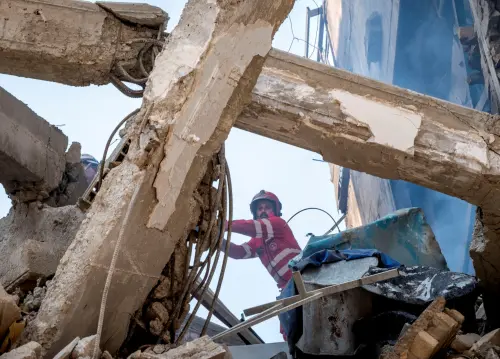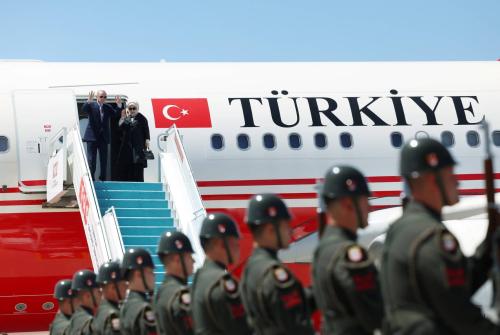Iranians took to the streets to protest the government’s shoot-down of a Ukrainian passenger jet. Though the crisis has abated, relations between the United States and Iran will never go back to normal, write Christopher Clary and Caitlin Talmadge. This piece originally appeared in the Washington Post.
Despite the tragic shoot-down of Ukrainian International Airlines Flight 572 near Tehran, the United States and Iran appear to have avoided an all-out war in the aftermath of the high-profile U.S. drone strike that killed Iranian Maj. Gen. Qasem Soleimani. Iran’s retaliatory missile strikes into Iraq did not cause any casualties, and both sides are clearly trying to find an off-ramp.
However, the U.S.-Iran relationship is unlikely to go back to business as usual, and the crisis has important consequences for longer-term regional stability.
Iran’s missiles are getting more accurate — which may constrain future U.S. basing and operations
Before the recent missile attacks, many public assessments of Iran’s missiles assumed they were fairly inaccurate. Satellite imagery of Iran’s recent barrage indicates those assessments may have been wrong. Iran recorded a fairly high rate of likely “hits” to “misses.” The lack of casualties may have been the result of Iran targeting areas of the bases with fewer personnel and more equipment, and not merely dumb luck and early warning.
This probably shows Iran now deploys fairly accurate short-range ballistic missiles, part of a global trend toward more accurate missiles that the Pentagon has predicted for years. The missiles are conceivably at least 10 times as accurate as the Soviet-origin Scud missiles that Iran and Iraq deployed against each other during their conflict in the 1980s.
In a future conflict, Iran could use precise conventional ballistic missiles to damage and degrade bases used by U.S. aircraft and harass and destroy ports upon which the United States would rely to deploy and resupply troops. It is difficult, if not impossible, to maintain a normal tempo of military operations in the face of incoming missiles.
The United States could shift to aircraft based on U.S. Navy aircraft carriers. However, these giant ships are themselves vulnerable, and there aren’t that many of them. Alternatively, the United States could use aircraft from more distant bases, out of range of Iranian missiles. This, however, would entail longer transit times to target and perhaps aerial refueling. That, in turn, would mean any future campaign would require more aircraft and be costlier than if Iran had not developed more-precise missiles. This situation would be dramatically different from the campaigns of 1991 and 2003, when U.S. bases were virtually invulnerable to missile attack.
The shooting down of a passenger jet shows that the crisis had its costs
The shooting down of a civilian aircraft showed how tragedies can occur during military crises, even when neither participant desires escalation.
Sadly, this is far from the first crisis in which one side mistook a civilian airliner for its opponent’s military aircraft. Similar incidents resulted in the shoot-down of a Malaysian passenger plane over Ukraine in 2014; an Iranian passenger airliner over the Persian Gulf in 1988, and a Korean Airlines plane that strayed into Soviet airspace in 1983.
The common ingredient in all of these episodes was a crisis or war that had at least one actor in a state of high alert. When that actor received ambiguous information — such as a warning of an unidentified incoming aircraft — it assumed the worst. Shooting first and asking questions later can have terrible consequences.
Iran has admitted that it was responsible for the Flight 572 mistake and that it feared the United States would launch retaliatory strikes on Iranian territory after Iran hit the Iraqi bases housing U.S. forces. An Iranian air defense operator, who was primed to expect incoming U.S. military aircraft and unable to get timely confirmation of the target’s identity, fired at a civilian jet instead.
When actors make decisions under stressful conditions with incomplete information — conditions that a crisis or war meets virtually by definition — they may become more rather than less likely to use force. The fog of war can induce not simply confusion but a type of worst-case thinking that promotes escalation rather than restraint. That dynamic could reemerge in future conflicts in the region, or beyond.
Ultimately, the crisis isn’t over yet
Some of Iran’s own citizens are accusing their government of negligence in causing the deaths of those aboard the Ukrainian airlines flight — the vast majority of whom were Iranian. Angry Iranians are taking to the streets. Such protests can easily have international consequences, as evidenced by the brief detention on Saturday of the British ambassador in Iran over alleged incitement.
Even apart from Iran’s domestic turmoil, plenty of potential flash points remain. Iran’s regional proxies remain strong and have many ways to target the United States and its allies, both overtly and covertly. The Trump administration’s decision to enact new economic sanctions is unlikely to coerce Iran and may instead drive it to lash out. Iran’s decision to recalibrate its adherence to the 2015 nuclear deal with world powers also puts the country back on a collision course with hawks in the United States and Israel.
As they say, things in the Middle East can always get worse — and they very well may.
The Brookings Institution is committed to quality, independence, and impact.
We are supported by a diverse array of funders. In line with our values and policies, each Brookings publication represents the sole views of its author(s).










Commentary
The US-Iran crisis has calmed down — but things won’t ever go back to how they were before
January 17, 2020